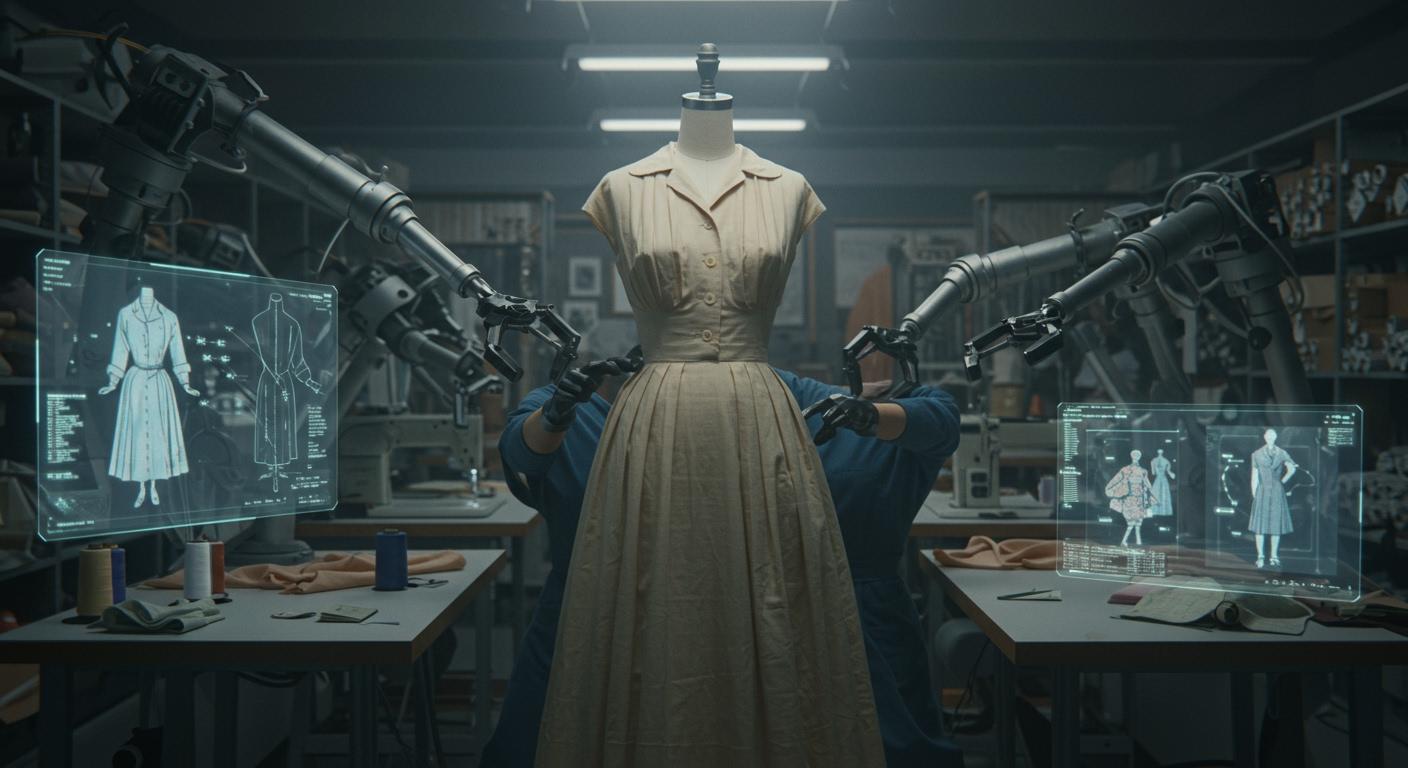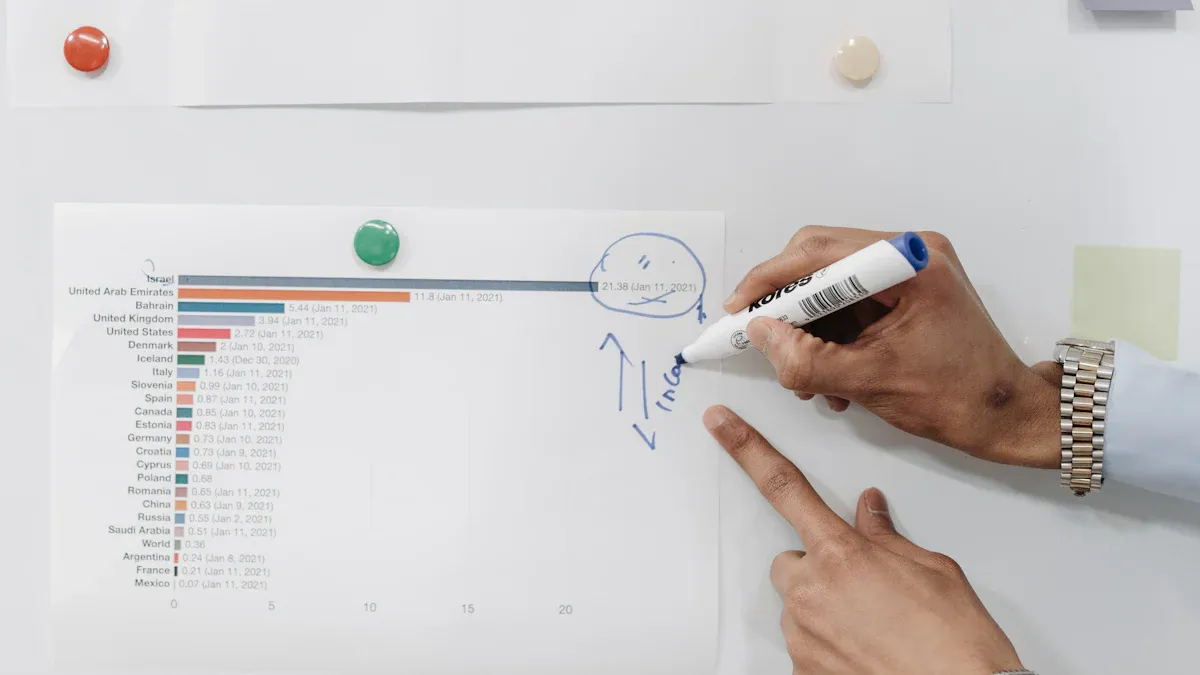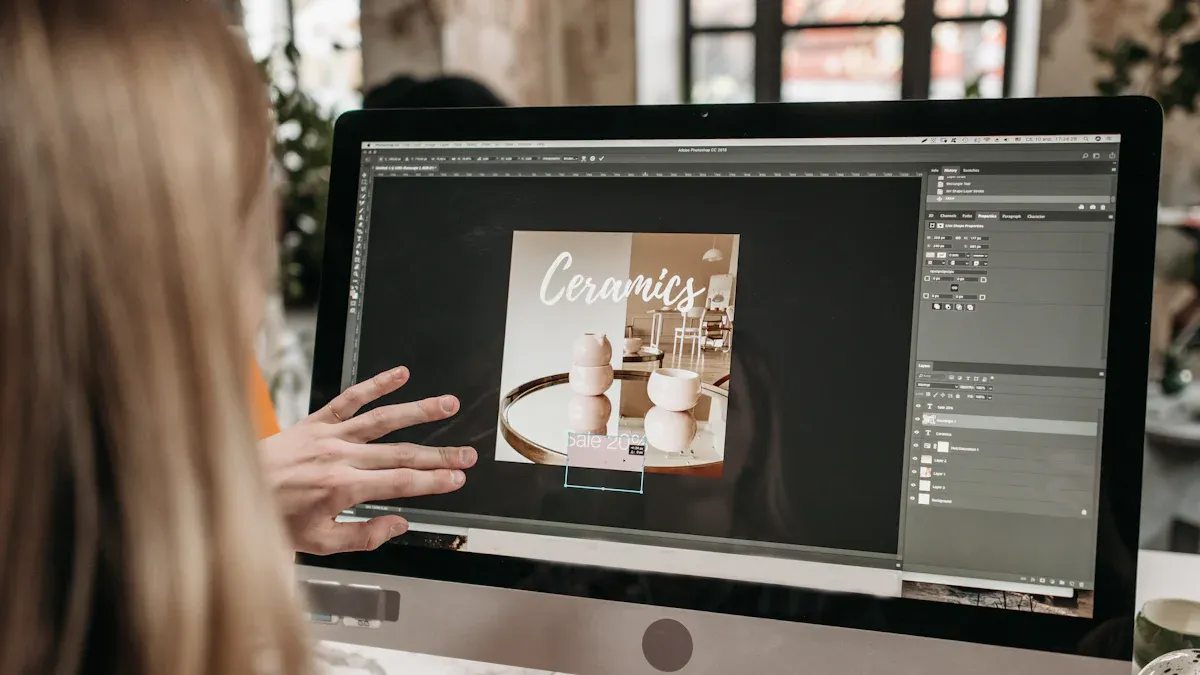
Artificial intelligence (AI) is revitalizing vintage fashion. AI creates a direct link between historical fashion visions and modern fashion design. The vintage fashion market is growing rapidly.
- The resale market is growing 15 times faster than traditional retail fashion.
- The US secondhand apparel market is projected to reach $73 billion by 2028.
AI achieves this by training on curated datasets of historical visual images. This process allows an AI to learn the core elements of any era's specific aesthetics. The AI learns the distinct visual aesthetics and vintage fashion aesthetics. This powerful AI process enables the generation of entirely new, vintage-inspired fashion designs. AI can replicate vintage fashion, offering endless visual inspiration and ai-crafted vintage fashion inspiration. The AI generates a unique vintage aesthetic style, providing visual inspiration for fashion. This ai-crafted vintage fashion inspiration helps designers explore a new vintage aesthetic, offering more visual inspiration for fashion. The AI provides great inspiration.
The Core AI Training Process

Replicating vintage fashion with artificial intelligence is not magic. It is a structured process. This process transforms historical data into new visual concepts. It begins with collecting the right images and ends with guiding the AI to create a specific style.
Curating the Vintage Dataset
The foundation of any great AI model is its data. For vintage fashion, this means creating a high-quality dataset of historical images. The quality of this dataset directly impacts the AI model's ability to learn a vintage aesthetic. A successful dataset requires careful curation.
- Ensure Variability: The image collection must show real-world variations. For a 1950s fashion model, this includes different lighting, angles, and backgrounds. This diversity helps the AI generalize its learning.
- Perform Quality Checks: Every image should be clear and well-lit. The object of interest, like a dress or accessory, must be easy to identify. Blurry or dark images can confuse the AI models.
- Balance Quantity and Quality: Deep learning models need many images, but quality is just as important. The dataset should have a balanced number of images for each fashion style to avoid bias.
Designers and researchers can find excellent visual resources in digital archives. Institutions like the Victoria and Albert Museum, The Metropolitan Museum of Art, and the Kyoto Costume Institute offer vast online collections. These archives provide high-resolution images of historical fashion, perfect for training AI models.
Training the AI Models
Once the dataset is ready, the next step is training the AI models. Two primary types of models are used for generating fashion imagery: Generative Adversarial Networks (GANs) and Diffusion Models.
- Generative Adversarial Networks (GANs): These AI models use a two-part system. A "Generator" creates new images, while a "Discriminator" judges them. The Generator tries to fool the Discriminator by making its images look real. This competition pushes the AI to produce highly realistic fashion designs.
- Diffusion Models: These models work differently. They take a clear image, slowly add digital noise until it is unrecognizable, and then learn how to reverse the process. To generate a new image, the AI starts with random noise and carefully removes it step-by-step to create a clean, new visual.
While both are powerful, they have different strengths. This cutting-edge ai technology offers designers distinct options.
| Aspect | GANs | Diffusion Models |
|---|---|---|
| Training Method | A generator and discriminator compete. | The model learns to remove noise gradually. |
| Output Quality | Very sharp images but can lack variety. | High diversity but sometimes softer details. |
| Training Stability | Can be unstable and difficult to train. | Very stable and predictable. |
| Inference Speed | Very fast, generating images in one step. | Slower, requiring multiple steps. |
Modern tools also offer advanced ai capabilities. For example, features like multi-image fusion allow an AI to analyze several images of one person. This helps the AI create a consistent character or model across different fashion visuals, which is essential for lookbooks and campaigns.
Guiding a Specific AI Style
After training, designers can guide the AI to generate a specific vintage style. This is where creative control comes into play. The AI can be fine-tuned on a smaller, more specific dataset. For instance, to replicate the unique visual style of 90s anime, an AI can be trained exclusively on images from that era. This precision allows the AI to learn the distinct line art, color palettes, and character designs of that specific fashion aesthetic.
Designers can also use prompts to direct the AI models. A detailed text prompt can describe the desired garment, fabric, and setting. Negative prompts are another powerful tool for refining the output.
Tip: To achieve a vintage film look, a designer can use negative prompts to steer the AI away from modern elements. For example, adding terms like
digital, sharp focus, oversaturated, modern styleto the negative prompt tells the AI what to avoid, helping it produce a more authentic vintage visual.
This level of control empowers creators to explore any vintage fashion era. The AI acts as a collaborator, turning a designer's vision into a stunning visual reality. The combination of curated data, powerful AI models, and precise guidance makes it possible to bring any fashion style from the past into the present.
AI's Impact on Modern Fashion Design

Artificial intelligence is changing how modern fashion works. AI provides powerful tools for designers. These tools speed up creativity and bring historical aesthetics into today's market. AI helps designers generate new ideas, replicate vintage fashion, and create entire photoshoots digitally. This technology offers endless ai-crafted vintage fashion inspiration.
Generating Novel Concepts
AI-driven creative tools dramatically accelerate the fashion design timeline. Generative AI allows designers to explore many ideas very quickly. They can turn a simple sketch or mood board into dozens of designs in seconds. This speed helps brands keep up with fast-changing fashion trends. It also reduces the need for many physical prototypes. AI can cut the time from concept to sample from eight weeks to less than three. This gives designers more freedom for creative exploration and ai-crafted vintage fashion inspiration.
Text-to-image tools like Midjourney are central to this process. Designers use detailed text prompts to create unique fashion pictures and design concepts. The AI generates a visual based on the words. This process provides instant inspiration. For example, a designer can explore different vintage aesthetics with specific prompts.
- 1950s Style Vintage Clothing: A prompt can ask for a hyper-realistic photo of a model in vintage clothing, 1950s style, with pin-up aesthetics and classic elegance.
- Gothic Fashion with Victorian Influence: A designer might request a hyper-realistic image of a model in gothic fashion, using words like
dark,mysterious, andmoody lightingto guide the AI. - Old Hollywood Glamour: A prompt for old hollywood outfits could describe a sequined gown, a fur stole, and a vintage car to capture the iconic styles of that era.
- 1960s Style with Futuristic Details: A prompt can merge retro 1960s outfits with advanced materials, creating a unique visual style.
This method gives designers a powerful source of ai-crafted vintage fashion inspiration. It allows them to mix and match eras, materials, and aesthetics with ease. The AI provides a constant stream of visual ideas for fashion.
How AI Can Replicate Vintage Fashion
AI excels at recreating the specific details that define vintage eras. This technology makes it possible to replicate vintage fashion with high accuracy. Designers can reimagine iconic styles from the past, such as glamorous old hollywood outfits. The AI can generate new versions of these looks, preserving their timeless elegance while adding a modern twist. This process offers amazing ai-crafted vintage fashion inspiration.
A key part of this is replicating historical textile patterns and prints. Specific AI tools are built for this task.
- Platforms like Refabric's AI suite allow users to digitize and analyze cultural motifs. The AI can then generate countless new patterns that retain the original design's essence.
- Tools such as Pietra AI let designers apply historical patterns to modern clothing items. A user can upload a photo of a dress and ask the AI to change its fabric to an Art Deco print.
- General-purpose AI models like Midjourney and DALL-E 3 can also generate seamless patterns from text prompts, perfect for creating custom retro fabrics.
These tools give designers direct access to historical aesthetics. They can explore the elegance of old hollywood outfits or the bold prints of the 1970s. This ability to replicate vintage fashion connects past creativity with future design. It is a great source of inspiration for any fashion project. The AI helps bring iconic styles and their unique elegance back to life.
Creating Vintage Models and Photography
AI also transforms how brands create visual content. It can generate photorealistic vintage models and entire retro photoshoots without a physical camera or live models. This facilitates the creation of retro clothing lookbooks and product photography. The process builds compelling visual narratives for a fashion collection. It provides a new channel for ai-crafted vintage fashion inspiration.
Creating a digital lookbook with AI involves several steps. Brands first define a theme, like the duality of daytime and evening old hollywood outfits. Then, AI tools create consistent digital models using detailed prompts and reference images. The AI generates scenes with specific lighting and backgrounds to match the desired vintage aesthetic. An "AI director" can even refine the cinematic quality of the visual, suggesting camera angles to enhance the storytelling. This produces hyper-realistic ai-generated content. The final images and video clips are assembled into a cohesive lookbook that tells a story, offering rich inspiration.
| Technique/AI Model | Application in Photorealistic Model Creation |
|---|---|
| Multi-image fusion | Ensures consistent model appearance across all generated visuals by using reference photos of a chosen digital model avatar. |
| Detailed Prompt Engineering | Describes model characteristics and scene elements, such as a dimly lit Art Deco lounge for old hollywood outfits. |
| Flux Pro / Runway Gen-4 | Ideal for high levels of detail and dramatic lighting, achieving photorealistic results in complex scenes. |
| Nolan AI Director | Refines cinematic quality, suggesting camera angles and lighting to enhance visual narratives. |
| Kling V2.1 Pro | Generates short video clips to add dynamism, showcasing garment movement for retro fashion. |
This technology offers incredible creative freedom. However, creating accurate 3D models of vintage garments presents challenges. The complexity of soft materials is difficult for AI to simulate perfectly.
Where the industry falls short from a 3D perspective is giving an accurate and trustworthy digital twin, versus something aspirationally correct. The accuracy of their simulations arises from modelling the actual mechanical performance of soft materials on soft bodies, which is very complex.
Despite these hurdles, AI is a powerful tool for creating retro visual content. It allows brands to showcase their fashion with stunning photorealistic results. The technology helps build strong visual narratives around iconic styles and old hollywood outfits, providing endless ai-crafted vintage fashion inspiration. The models generated by AI bring a unique elegance to the vintage aesthetic, making the fashion feel both classic and new. This is a great source of inspiration for designers.
Challenges and the Future in AI Fashion
While AI offers exciting tools for vintage fashion, it also presents new challenges. The industry must address issues of authenticity, data bias, and the changing role of human designers. The future of fashion depends on navigating these complexities.
The Authenticity Challenge
Using AI to replicate vintage fashion raises important legal questions. Copyright law often requires significant human control for a design to receive protection. An AI might generate a work without this input. This creates a risk for the fashion industry. AI could mimic copyrighted works, which might deprive human creators of fair payment. Transparency is a key solution. Many experts suggest that brands should clearly label AI-generated fashion to distinguish it from human creations. This helps protect the value of original vintage designs.
Data Bias and Representation
The data used to train an AI can contain biases. If a dataset for vintage fashion mostly shows one culture or body type, the AI will learn to favor it. This can lead to a lack of diversity in AI-generated fashion. Developers use several methods to fight this bias.
- Interdisciplinary Collaboration: Experts from different fields work with engineers to identify bias early.
- Data Augmentation: Technical methods add variations to images, helping the AI learn from a more balanced dataset.
- Human Monitoring: People continuously watch the AI to catch and correct new biases that may appear over time.
These strategies help ensure the AI produces more inclusive and representative fashion concepts.
The Future: Human-AI Collaboration
The future of fashion is not about AI replacing humans. It is about collaboration. This cutting-edge ai technology will empower designers. AI will help the fashion industry become more sustainable by tracking environmental impact. This advanced ai capabilities will also improve online shopping through virtual try-ons, creating personalized vintage experiences. This partnership between human creativity and AI is creating new job roles.
New positions like Creative Technologists and Digital Fashion Specialists are emerging. These professionals merge traditional fashion knowledge with AI tools. They create virtual garments and immersive digital fashion shows.
This collaborative style shows that AI is a powerful partner. The combination of human intuition and AI analysis will drive the future of vintage fashion innovation.
AI replicates vintage fashion through a structured process of data curation, model training, and guided generation. This technology empowers fashion designers by automating the search for ai-crafted vintage fashion inspiration and recreating patterns. AI connects historical fashion archives with contemporary design studios, providing a new vintage aesthetic and endless inspiration. The future of fashion design is a collaborative partnership, blending human creativity with AI's analytical power to achieve timeless elegance. This approach to fashion ensures AI serves as a tool for inspiration, not a replacement for the designer, preserving the unique aesthetics and elegance of vintage style. This AI method provides great ai-crafted vintage fashion inspiration, and this ai-crafted vintage fashion inspiration helps fashion. The AI offers ai-crafted vintage fashion inspiration and new aesthetics. The elegance of this design provides more ai-crafted vintage fashion inspiration.
This human-AI collaboration is the key to unlocking new fashion aesthetics and inspiration, ensuring the vintage fashion world continues to evolve with modern technology. The AI helps create a beautiful vintage design with unique aesthetics.
FAQ
See Also
AI's Role in Managing Rapidly Evolving Fast Fashion Trends
Innovative AI Solutions for Sustainable and Eco-Friendly Fashion Practices
Optimizing Fashion Returns: Smart AI Solutions for Enhanced Efficiency
Revolutionizing Fashion Retail: Dynamic AI for 2025 Safety Stock
Unveiling Global Fashion Demand Through Advanced Robotic Insights